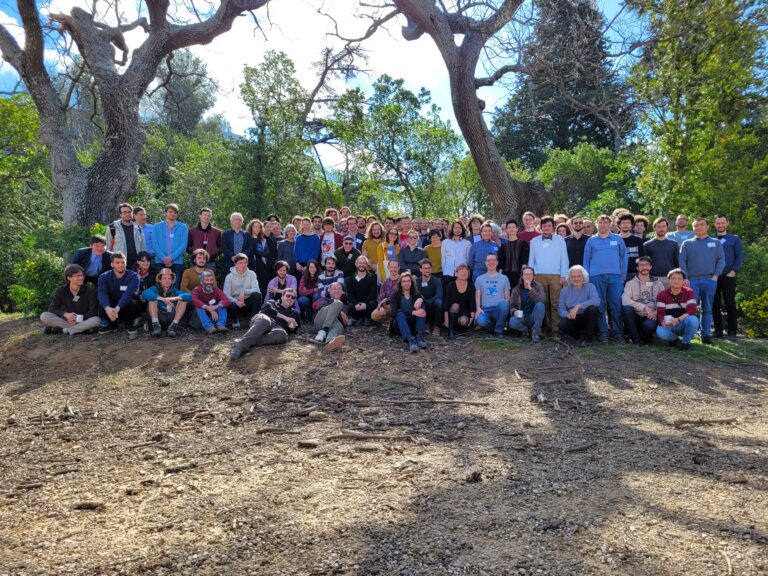MULTIYEAR PROGRAM
RESEARCH SCHOOL - ÉCOLE DE RECHERCHE
Scientific Committee
Comité scientifique
Mathilde Bouvel (CNRS, Université de Lorraine)
Luc Devroy (Mc Gill University)
Éric Fusy (CNRS, Université Gustave Eiffel)
Conrado Martinez (Polytechnic University of Catalonia)
Organizing Committee
Comité d’organisation
Julien Clément (CNRS – Université Caen Normandie)
Julien Courtiel (Université Caen Normandie)
Julien David (Université de Caen Normandie)
Marni Mishna (Simon Fraser University)
The annual meeting Aléa is dedicated to the study of random discrete structures arising in various scientific domains, mainly in theoretical computer science, combinatorics and probability theory, but also in statistical physics, bioinformatics or in other branches of mathematics.
These structures are, for example, trees, words, permutations, lattice walks, more geometrical objects like planar maps, or other objects related to discrete dynamics like cellular automata. Aims and methods are diverse, ranging from enumeration, asymptotic properties and analytic combinatorics, probability, random generation…
The Aléa meeting is closely related to the community of the Working Group Aléa of the “Groupement de recherche CNRS” gdr-im, which was created in the 90’s under the impulse of Philippe Flajolet to promote interactions between combinatorics and probability around the analysis of algorithms. In the last ten years it has been the birth place to many fruitful interdisciplinary collaborations (e.g. on planar maps, walks in quarter plane, algebraic urns…) and it has grown into one of the most active interface between computer scientists and mathematicians in France. The program of the conference aims both at broadening the common knowledge of the participants via mini-courses and invited long talks, and at reflecting the variety and dynamism of the community via short talks that are selected through an open call.
Les journées Aléa sont consacrées à l’étude de l’aléa discret, i.e. l’étude des structures aléatoires discrètes telles qu’elles apparaissent dans diverses disciplines, principalement l’informatique théorique, la combinatoire et la théorie des probabilités, mais aussi la physique statistique, la bio-informatique ou d’autres branches des mathématiques.
Les objets d’études sont par exemple les arbres, les mots, les permutations, les chemins, ou des objets plus géométriques comme les cartes, ou encore liés à une dynamique discrète comme les automates cellulaires. Les objectifs et les méthodes utilisées sont divers : l’énumération, les propriétés asymptotiques et la combinatoire analytique, les propriétés probabilistes, la génération aléatoire…
Les journées Aléa sont étroitement liées à la communauté du groupe de travail Aléa du gdr-im, créé à l’initiative de Philippe Flajolet vers la fin des années 90 pour favoriser les interactions entre combinatoristes et probabilistes autour de l’analyse d’algorithmes. Au cours de ces dix dernières années, elles ont été le creuset de nombreuses et fécondes collaborations interdisciplinaires (e.g. autour des cartes planaires, des marches dans le quart-de plan, des urnes algébriques…) et elles sont devenues lieu d’expression de l’une des interfaces math/info les plus actives en France. Le programme répond au double objectif d’assurer une forme de formation continue de la communauté au travers de cours invités et d’exposés longs, et de refléter sa diversité et son dynamisme au travers d’exposés courts sélectionnés via appel à propositions.
MINI-COURSES
Durée: 2x1h15 + 1h d’exercices
We will overview two probabilistic methods used to prove the existence of diverse combinatorial objects with desired properties: First, we will introduce Lovász Local Lemma as a classical tool to prove that, informally speaking, with non-zero probability none of the “bad” events occur if those bad events are of low probability and somewhat essentially independent from each other. Next, we will move on to its algorithmic counterpart, the Entropy Compression Method, used to ensure that a randomized algorithm eventually finds a solution with desired properties. The two methods will be illustrated by applying them to various settings in graph theory, combinatorics, and geometry.
The course presents the mathematical software SageMath and most specifically its usage for research in combinatorics. We will focus on families of combinatorial objects, especially related
to the Tamari lattice, and their implementation in the context of object oriented programming.
EXPOSÉS TUTORIELS
Durée: 1h
Motivated by the discovery of hard-to-find social networks in epidemiology, we consider the question of exploring the topology of random structures (such as a random graph G) by random walks. The usual random walk jumps from a vertex of G to a neighboring vertex, with providing information on the connected components of the graph G. The number of these connected components is the Betti number beta0 . To gather further information on the higher Betti numbers that describe the topology of the graph, we can consider the simplicial complex C associated to the graph G: a k-simplex (edge for k = 1, triangle for k = 2, tetrahedron for k = 3 etc.) belongs to C if all the lower (k − 1)-simplices that constitute it also belong to C. For example, a triangle belongs to C if its three edges are in the graph G. Several random walks have already been proposed recently to explore these structures. We introduce a new random walk, whose generator is related to a Laplacian of higher order of the graph and to the Betti number betak . A rescaling of the walk for k = 2 (cycle-valued random walk), and on regular triangulation of the torus, is also detailed. We embed the space of chains into spaces of currents to establish the limiting theorem.
Joint work with T. Bonis, L. Decreusefond and Z. Zhang.
Dans cette exposé, je présente une approche d’énumération asymptotique du type guess-and- check pour certaines récurrences, à travers de l’étude des arbres binaires compactés. Un arbre binaire compacté est un graphe acyclique dirigé qui encode un arbre binaire, où on garde une seule copie pour les sous-arbres identiques. Nous prouvons que le nombre des arbres binaires compactés de taille n est asymptotiquement Θ(n!4^n exp(3 a_1 n^(1/3) )n^(3/4) ), avec a_1 ∼ −2.338 la plus grande racine de la fonction d’Airy. Typiquement, cette expression asymptotique contient un exponentiel étiré, qui est rare et intéressant dans l’énumération asymptotique. Pour arriver à ce résultat, nous postulons d’abord une récurrence à deux paramètres pour ces nombres, puis nous devinons la forme de l’asymptotique et la démontrons toujours à travers de la récurrence. Je présenterai aussi quelques autres applications, et notre effort à généraliser cette méthode.
Travail commun avec Andrew Elvey Price et Michael Wallner.
Formal language membership is a classical problem with myriad applications. Intuitively, the goal is to succinctly describe the subset of strings that carry important information in order to be able to identify them efficiently. For instance, searching for all substrings that belong to a given regular language is a common task in web scraping. Furthermore, determining the well-formedness of a data file can be reduced to the Dyck language membership problem. Moreover, repetitions in biological sequences, such as palindromes and squares, often indicate sites of functional significance. The quick growth of data volume and the presence of noise in applications demand efficient and robust methods for membership testing, and this tutorial will provide a survey of such methods and open questions.
SHORT TALKS
Rafik Aguech (King Saud University) Exponentially preferential trees
Eleanor Archer (Université Paris Nanterre) La percolation critique « quenched » sur les arbres de Galton-Watson
Philippe Biane (Université Gustave Eiffel) Intervalles de Tamari gloutons et constellations
Ariane Carrance ( Ecole polytechnique) Recursions for Ising triangulations
Alice Contat (Université Sorbonne Paris Nord) Coeurs critiques sur des graphes aléatoires
Victor Dubach (Université de Lorraine) Permutations invariantes par conjugaison : une approche géométrique
Solal Gaudin (Université Claude Bernard Lyon 1) Un système de particules discret, et les placements de tours
Mostafa Gholami (Université de Caen) On the average complexity of berge algorithm
Nathanaël Hassler (Université de Bourgogne) Grand zigzag knight’s paths
Corentin Henriet (Université Paris Cité) Des formules d’énumération de cartes via les arbres de parking
Mohamed Slim Kammoun (ENS Lyon) Universalité pour les permutations stables par conjugaison
Théo Lenoir (Ecole Polytechnique) Concentration de la taille du plus grand sous-graphes communs à deux hypergraphes aléatoires
Ludovic Morin (Université de Bordeaux) Probabilité que n points soient en position convexe dans un κ-gone régulier : Résultats asymptotiques
Thomas Muller (Université de Bordeaux) 4-edge colored graphs and their scheme
Victor Nador (Polish Academy of Sciences) Contraintes pour des constellations b-déformées
Khaydar Nurligareev (Université de Bourgogne) Asymptotics of endhered patterns in perfect matchings
June Roupin (Université Gustave Eiffel) Forme normale alternante dans le monoïde de tresse standard
Zéphyr Salvy (Université Gustave Eiffel) Transition de phase des cartes boisées aléatoires décomposées par blocs
Meltem Unel (Université Paris-Saclay) La tessellation idéale de Poisson-Voronoï sur les espaces hyperboliques










